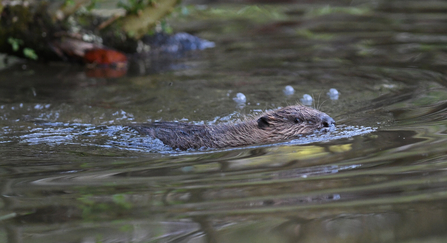Beavers could be making a comeback to Gloucestershire after an absence of more than four centuries. Although there have been fenced reintroductions into the county, including at Greathough Brook in the Forest of Dean and Cotswold Water Park, if successful this will be the first time a wild reintroduction takes place in Gloucestershire. The project is being jointly managed by Gloucestershire Wildlife Trust (GWT) and Forestry England and is currently in its initial stages, with GWT launching their appeal to get the work started.
Could a mammal once hunted to extinction make a comeback to Gloucestershire?
Beaver - Nick Upton/Cornwall Wildlife Trust

David Parkyn - David Parkyn/ Cornwall Wildlife Trust
The charity are raising money to carry out a feasibility study, which will allow them to identify the best locations for beaver reintroductions, as well as locations that won’t work. GWT’s Ecosystem Recovery Manager Anna Tarbet said,
“The beaver feasibility study will be assessing what’s possible when it comes to reintroductions here in Gloucestershire. We’ll be looking at biological aspects, such as where’s the right habitat, but also what impact they could have on humans and humans on them.”
Anna was keen to stress the focus the feasibility study will have on social considerations,
“We’ll be working with landowners and communities every step of the way, making sure we understand the possible impact of beavers on agriculture and livelihoods at any proposed location. It’s a true feasibility study, so we’re not going in with any locations in mind. It’s really exciting to see where the project will take us.”
The benefits of beavers as ecosystem engineers are well-documented. Contrary to what many of us believe, they’re vegetarian and only cut down the amount of wood they need to construct their dams. It’s these dams that have an incredible positive impact on the landscape around them, creating vibrant wetlands where countless species can thrive. These wetlands increase biodiversity, sequester carbon, store water and improve flood attenuation.
Beaver - David Parkyn/ Cornwall Wildlife Trust
Ben Robinson, Planning and Environment Manager at Forestry England is pleased to be working collaboratively on a project that will explore where beavers could benefit the wider Gloucestershire landscape,
“We have already seen the changes beavers can bring to a landscape at Greathough Brook. These amazing animals are a keystone species, and known as an ecosystem engineer they can restore habitat, by creating feeding and breeding opportunities for a range of other wildlife. It’s fantastic to be exploring opportunities to bring back a free-living beaver population to the county.”
Notes to editors
Gloucestershire Wildlife Trust (GWT) works closely with local communities, landowners and partners to deliver much-needed conservation work across more than 1000 hectares of nature reserves, and within the wider landscape of Gloucestershire. This vital work safeguards these remaining special wild places and drives nature’s recovery, working towards a future where the countryside thrives once more with wildlife, wildflowers, trees, butterflies, insects and animals
The charity also delivers a vast range of engagement activities and projects across the county, as well as providing free public access to its nature reserves, enabling people from all backgrounds to spend time outdoors and get closer to nature.
Forestry England (FE) manages and cares for the nation’s 1,500 woods and forests, with over 363 million visits per year. As England’s largest land manager, we shape landscapes and enhance forests for people to enjoy, wildlife to flourish and businesses to grow. We are continuing the work we have already started to make the nation’s forests resilient to climate change and by 2026 we will:
- create at least 6,000 more hectares where we integrate wilding activities in our productive forests.
- increase the diversity of visitors to the nation’s forests and have one million hours of high-quality volunteer time given to the nation’s forests
- plant at least 2,000 hectares of new, high quality, predominantly broadleaf woodlands
For more information visit forestryengland.uk.
Forestry England is an agency of the Forestry Commission.
